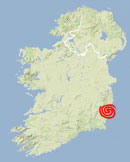08 Sep Árd Ladhran
“The Age of the World, to this Year of the Deluge, 2242. Forty days before the Deluge, Ceasair came to Ireland with fifty woman and three men — Bith, Ladhram, Fintain their names. Ladhra died at Árd-Ladhrann and from him it is named. He was the first that died in Ireland.”
Lebor Gabála Éren (The Book of Invasions), c. eleventh century1
Drag within the image to explore Árd Ladhran in virtual reality.
According to the annals, there were no people living in Ireland prior to the coming of these invaders. This mound of Árd Ladhran was, in legend, the tomb of Ladhra, who was interred there 40 days before Noah’s Ark set sail, making Ladhra the first man to die in Ireland. The story also asserts that, with his 16 wives, he died “of excess of women.”2
This perfectly round mound, at the edge of the large cemetery outside Ardamine, is not mentioned in most guidebooks to Ireland’s prehistoric monuments. It has never been excavated, and may even hide a passage tomb. Yet for earlier generations of antiquarians, those more inclined to take the chronicles in The Book of Invasions as literal history, this was the geographical proof of an event in the distant past;. A sign was erected, now mostly obscured, that labels it “Árd Ladhran.” This sign is visible in the virtual reality environment just behind the white cross at the edge of the cemetery.
While editing his translation of the The Annals of the Four Masters around 1850, John O’Donovan made the judgment that the parish of Ardamine must be the same as the Árd Ladhrann mentioned in the Annals.3 Different sources point to the existence of an ancient cross to be found atop the mound, or a dolmen, but neither can be located now.
Another reference to Ladhran occurs in the name of a treacherous stretch of ocean off the Irish coast, called Tuile Ladhrann. This area of the Irish sea was known to sound an “ominous roar” which would announce the arrival of a dangerous storm.
“On a calm evening, with the wind from a southerly direction, the sea out on the bar gives forth a strange ominous roar as the tide comes in. I have heard it many times from over twenty miles inland and noticed that within twelve hours a fierce storm would follow. The ancients attributed it to the gods of the sea venting their anger for the misdeeds of their people.” 4
Árd Ladhran was also mentioned as the location of a famous battle between Heber and Heremon and their armies. The final battle was fought at this spot, where the sons of Heremon were defeated and their armies destroyed.5
Whatever enchantments this place has held throughout prehistory—magical wave, tomb of the first man to die in Ireland, site of a heroic battle—it has also been used as the final resting place of a much more modern worker of miracles.
Rev. William Webb (1925 – 1941) is buried just to the side of the Árd Ladhran mound. A controversial figure, often at odds with the ecclesiatical authorities, he had a reputation as a faith healer, working through his devotion and reputed ability to intercede with the Little Flower (Sainte-Thérèse of Lisieux). People from all regions would visit him to request his prayers for relief from their spiritual and physical maladies.6 Fr. Webb’s grave, with the offerings and supplications still left by the faithful 70 years after his death, may be seen in the virtual-reality environment, 180° opposite the mound of Árd Ladhran. Click the hotspot to see his grave in a close-up view.
Click here to see all the notes from this page.
Árd Ladhran, Co. Wexford
Nearest Town: Ardamine
Townland: Askingarran Lower
Latitude: 52° 37′ 51.0″ N
Longitude: 6° 13′ 52.1″ W

